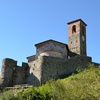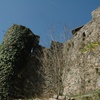Fort of Ceserana
The fort of Ceserana consists of a single wall with, on the south side, two formidable semi-circular towers and a smaller one. The only entrance, defended by two parallel curtain walls, is also located in the southern portion of the walls and was accessible only by climbing a steep staircase. The interior is almost completely occupied by an ancient church dedicated to St. Andrew, and next to this building of worship is a bell-tower that also served as watchtower.
Of the original construction, most of the defensive structures remain standing. Recent restoration succeeded in recovering this architectural complex from the degradation afflicted with the loss of its defensive function.
Definitely not to be missed is the Romanesque church of St. Andrew, which dates from the 12th-13th centuries but was based on an older building. The church, built in white stone with a semi-circular apse, is decorated with pilasters and capitals of floral and anthropomorphic motifs. Inside there are two wooden statues dating from 1300, representing St. James (attributed to Pietro d'Angelo) and St. Andrew.
Historical notes
Belonging to the Rolandinghi family from 996, the community of Ceserana was endowed with a fortress probably before 1048, the year of its first written account. The castle, however, gained importance during the 12th century when the expansionist ambitions of the city of Lucca extended to the Garfagnana region, arousing alarm among some factions of the nobility which until then had controlled the territory. In 1171, the armies of Lucca were able to win over the men of Ceserana and occupy the fortress, causing a lot of damage on that occasion to the defensive structures.
The fortification, having been delivered peacefully to Castruccio Castracani in 1319, probably could not resist the ravages of time and raids by the Pisani because it did not feature on the list of castles in 1374 enumerated for the Golden Bull.
Nonetheless , the strategic importance of the site convinced Paolo Guinigi to enter the castle in the list of those he wanted to restore, enhance and equip. In 1451, however, Ceserana voluntarily entrusted itself to the Duke of Este. Many successive restorations and renovations followed, but the most important were completed in 1474 and in 1616. In 1622, the community of Ceserana was divided into three distinct areas, which still exist, defined as Ceserana, or the walled village, Migliano and Rocca. Even in 1779 the small fort was in use and was endowed with its own chapel.










